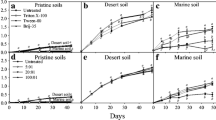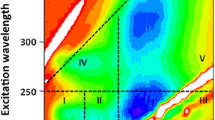Abstract
Biosurfactants are frequently used in petroleum hydrocarbon and dense non-aqueous phase liquids (DNAPLs) remediation. The applicability of biosurfactant use in clayey soils requires an understanding and characterization of their interaction. Comprehensive effects of surfactants and electrolyte solutions on kaolinite clay soil were investigated for index properties, compaction, strength characteristics, hydraulic conductivities, and adsorption characteristics. Sodium dodecyl sulfate (SDS) and NaPO3 decreased the liquid limit and plasticity index of the test soil. Maximum dry unit weights were increased and optimum moisture contents were decreased as SDS and biosurfactant were added for the compaction tests for mixtures of 30% kaolinite and 70% sand. The addition of non-ionic surfactant, biosurfactant, and CaCl2 increased the initial elastic modulus and undrained shear strength of the kaolinite–sand mixture soils. Hydraulic conductivities were measured by fixed-wall double-ring permeameters. Results showed that the hydraulic conductivity was not significantly affected, but slightly decreased from 1×10−7 cm/s (water) to 0.3×10−7 cm/s for Triton X-100 and SDS. The adsorption characteristics of the chemicals onto kaolinite were also investigated by developing isotherm curves. SDS adsorbed onto soil particles with the strongest bonding strength of the fluids tested. Correlations among parameters were developed for surfactants, electrolyte solutions, and clayey soils.











Similar content being viewed by others
References
Acar YB, Hamidon A, Field SD, Scott L (1985) The effect of organic fluids on hydraulic conductivity of compacted kaolinite. Hydraulic barriers in soils and rock. ASTM STP 874, pp 171–187
Acros Organics (1995) Handbook of fine chemicals. Fisher Scientific, Pittsburgh
Anderson DC, Crawley W, Zabcik JD (1985) Effects of various liquids on clay soil: bentonite slurry mixtures. Hydraulic barriers in soil and rock. ASTM STP 874, pp 93–103
ASTM D1331-89 (1989) Standard test methods for surface and interfacial tension of solutions of surface-active agents. American Society for Testing and Materials, Pennsylvania
ASTM D1557-90 (1990) Standard test methods for laboratory compaction characteristics of soil using modified effort (56,000 ft-lbf/ft3 (2,700 kN-m/m3)). American Society for Testing and Materials, Pennsylvania
ASTM D2166-85 (1985) Standard test method for unconfined compressive strength of cohesive soil. American Society for Testing and Materials, Pennsylvania
ASTM D2487-00 (2000) Standard classification of soils for engineering purposes (Unified Soil Classification System). American Society for Testing and Materials, Pennsylvania
ASTM D421-85 (1985) Standard practice for dry preparation of soil samples for particle-size analysis and determination of soil constants. American Society for Testing and Materials, Pennsylvania
ASTM D422-63 (1963) Standard test method for particle-size analysis of soils. American Society for Testing and Materials, Pennsylvania
ASTM D4318-00 (2000) Standard test method for liquid limit, plastic limit and plasticity index of soils. American Society for Testing and Materials, Pennsylvania
ASTM D698-90 (1990) Test method for laboratory compaction characteristics of soil using standard effort (12,400 ft-lbf/ft3 (600 kN-m/m3)). American Society for Testing and Materials, Pennsylvania
Bowders JJ, Daniel DE (1987) Hydraulic conductivity of compacted clay to dilute organic chemicals. ASCE J Geotech Eng 113(12):1432–1448
Broderick GP, Daniel DE (1990) Stabilizing compacted clay against chemical attack. ASCE J Geotech Eng 116(10):1549–1567
Cerniglia CE (1992) Biodegradation of polycyclic aromatic hydrocarbons. Biodegradation 3(2–3):351–368
Chu W, Kwan CY (2003) Remediation of contaminated soil by a solvent/surfactant system. Chemosphere 53(1):9–15
Das BM (1997) Principles of geotechnical engineering, 4th edn. PWS Publishing Company, Boston
Dunn RJ (1985) Laboratory measurement of fine-grained soil fluid conductivity. Eng Geol 21:215–223
Dunn RJ, Mitchell JK (1984) Fluid conductivity testing of fine-grained soils. ASCE J Geotech Eng 110(11):1648–1665
Edwards DA, Liu Z, Luthy RG (1994) Surfactant solubilization of organic compounds in soil/aqueous system. ASCE J of Environ Eng 120(1):5–22
Erickson DC, White E, Leohr RC (1991) Comparison of extraction fluids used with contaminated soils. Hazard Waste Hazard Mater 8(3):185–194
Fernandez F, Quigley RM (1985) Hydraulic conductivity of natural clays permeated with simple liquid hydrocarbons. Can Geotech J 22:205–214
Foreman DE, Daniel DE (1986) Permeation of compacted clay with organic chemicals. ASCE J Geotech Eng 112(7):669–681
Gleason MH, Daniel DE, Eykholt GR (1997) Calcium and sodium bentonite for hydraulic containment application. ASCE J Geotech Geoenviron Eng 123(5):438–445
Guha S, Jaffe PR, Peters CA (1998) Solubilization of PAH mixtures by a nonionic surfactant. Environ Sci Technol 32(7):930–935
Hueckel T, Kaczmarek M, Caramuscio P (1997) Theoretical assessment of fabric and permeability changes in clays affected by organic contaminants. Can Geotech J 34:588–603
Jafvert CT, van Hoof PL, Heath JK (1994) Solubilization of non-polar compounds by non-ionic surfactant miscelles. Water Res 28(5):1009–1017
Johnson AW, Sallberg JR (1960) Factors that influence field compaction of soils. Highway Research Board, p 272
Li J, Smith JA, Winquist AS (1996) Permeability of earthen liners containing organobentonite to water and two organic liquids. Environ Sci Technol 30(10):3089–3093
Lo IMC, Mak RKM, Lee SCH (1997) Modified clays for waste containment and pollutant attenuation. ASCE J Environ Eng 123(1):25–32
McNeal BL, Coleman NT (1966) Effect of solution on soil hydraulic conductivity. Proc Soil Sci Am 30(3):308–312
McNeal BL, Reeve RC (1964) Elimination of boundary-flow errors in laboratory hydraulic conductivity measurements. Proc Soil Sci Soc Am 28:713–714
Mesri G, Olson RE (1971) Mechanisms controlling the permeability of clays. Clays Clay Mater 19(3):151–158
Mitchell JK (1993) Fundamentals of soil behavior, 2nd edn. Wiley, New York
Mulder H, Wassink GR, Breure AM, Van Andel JG, Rulkens WH (1998) Effect of nonionic surfactants on naphthalene dissolution and biodegradation. Biotechnol Bioeng 60(4):397–407
Parker FJ, Benefield LD, Nelson MM (1986) Effects of organic fluids on clay permeability. In: Proceedings of 41st Purdue University industrial waste conference, pp 283–292
Quigley RM, Fernandez F, Yanful E, Helgason T, Margaritis A (1987) Hydraulic conductivity of contaminated natural clay directly below a domestic landfill. Can Geotech J 24:377–383
Rathfelder KM, Abriola LM, Singletary MA, Pennell KD (2003) Influence of surfactant-facilitated interfacial tension reduction on chlorinated solvent migration in porous media observations and numerical simulation. J Contam Hydrol 64(3–4):227–252
Ren X (1998) Application of a biosurfactant in naphthalene, phenanthrene, and TCE remediation. Doctoral dissertation, Department of Civil & Environmental Engineering, University of Houston
Sai JO, Anderson DC (1991) Long-term effect of an aqueous landfill leachate on the permeability of a compacted clay liner. Hazard Waste Hazard Mater 8(4):303–312
Sims RC, Sorensen D, Sims J, McLean J, Mahmood R, Dupont R, Jurinak J, Wagner K (1986) Contaminated surface soils in-place treatment techniques. Noyes Publications, Park Ridge
Sitting M (1991) Handbook of toxic and hazardous chemicals and carcinogens, 3rd edn. Noyes Publications, Park Ridge
Sivapullaiah PV, Savitha S (1999) Index properties of illite–bentonite mixtures in electrolyte solutions. ASTM Geotech Test J 22(3):257–265
Thorton JS (1990) Underground movement of gasoline on groundwater and enhanced recovery by surfactant. Ground Water 27(2):223–236
Uppot JO, Stephenson RW (1989) Permeability of clays under organic permeants. ASCE J Geotech Eng 115(2):115–131
US EPA (1986) Test method 9040. In: US EPA test methods for evaluating solid waste: physical/chemical methods, SW-846
Valsaraj KT, Gupta A, Harrison DP (1988) Partitioning of chloromethanes between aqueous and surfactant micellar phases. Water Res 22(9):1173–1183
Acknowledgements
This subject is supported by the Ministry of Environment, Korea as "The Eco-technopia 21 project" (grant No. 041-051-032).
Author information
Authors and Affiliations
Corresponding author
Rights and permissions
About this article
Cite this article
Park, J., Vipulanandan, C., Kim, J.W. et al. Effects of surfactants and electrolyte solutions on the properties of soil. Environ Geol 49, 977–989 (2006). https://doi.org/10.1007/s00254-005-0136-6
Received:
Accepted:
Published:
Issue Date:
DOI: https://doi.org/10.1007/s00254-005-0136-6




